It has been a long time guess on how much honey I will have for this year. Not that I need a lot of honey, it is more a measurement of how good a second year beekeeper, as me, has treated the Meadow Bees. Only happy workers that produce! Now it is time to face the truth. And I can not wait for it.
Last Friday, I took a day off to extract honey. It started in the early morning to clear the bees off the super boxes, that is the box where bees store honey and the queen is blocked from getting in by the queen excluder, so that there is no brood in the super, only honey. In the previous night, I put in a clearing board between the brood box and the supers, the clearing board only allows the bees to go down to the brood, but not going back easily. What is supposed to happen is, during the night, the bees go down to the brood box to warm the babies and in the morning, they find it difficult to go back to their honey stores. While that is the theory, surprisingly, I found a number of bees in the super on Friday morning and had to carefully brush them off frame by frame. They were really clever and discovered the super that was put aside and free of bees very soon and my dad had to run back to the house with each super as soon as they were cleared. I was enjoying it, the smell of honey and pollen around the open hives was just lovely.
Finally at 11:30am, cleared all the bees and all the supers are in the kitchen, all together four supers! Starting the extraction.
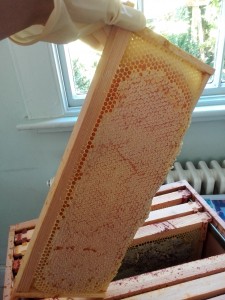
Step 1, was to de-cap the honeycomb. When each cell in the honeycomb is filled with honey, the bees put wax to cap it. Really each cell has to be de-capped, otherwise the honey won’t come out. I used a bread knife at the start, then found the de-capping fork actually worked better. The extractor I rented from my beekeepers’ association took eight frames, and it took me good part of an hour to de-cap all the eight frames, remember, no cells left uncapped 
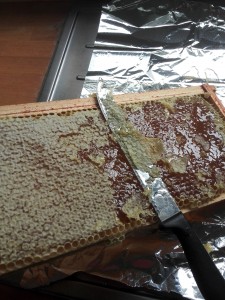
Step 2, extraction, that was easy. The frames were loaded into the electric extractor. It was switched on and started from low speed and then moved to higher speed. Honey just splashed out! I must have done a good job in balancing the frames, the extractor was steady on the floor. It was funny that someone actually managed to let it dancing across the floor 😉
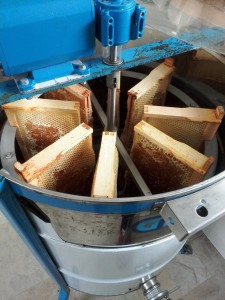
Step 3, straining. There are bits of wax in the honey, most people like clear honey without it. So we have to strain it. I used double sieves to strain the honey. I tell you it is slow, probably because the consistency of the honey at room temperature. It is quite thick. I heard the commercial producers heat the honey to speed up the process. Some even use ultra fine sieve to filter out the pollen, so the origin of the honey can not be traced. I don’t agree with that, local honey should be just as it is with all the goodness from the bees. I also don’t understand why all the commercial honey are blended – you see “blended from EU and non EU honey” in the label of Boyne Vally honey – I’ll need to do research on that. But my honey is straight from Meadow bees and I only did an extraction and I am happy with it.
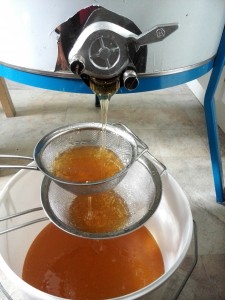
Finally finished with the extraction, left the clean up to the next day since it was 6pm.
Now it is time to reveal my honey harvest. It is nearly 40 Kilo grams! This is just from 1 production hive, with the other 2 hives join force next year, my goodness, I’ll have too much honey! Not something I should complain. I have done the right things for my bees and my Meadow bees have got a very good year!
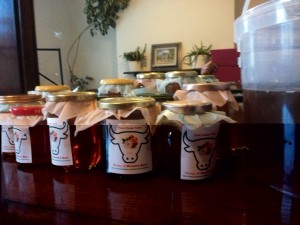
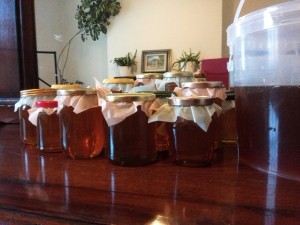
Thanks for the honey. It is totally delicious and living so close to you, I’m assuming the flowers from my garden are contributing to the fabulous flavour. Couldn’t get more local honey for Marla who suffers from hay fever. Lovely blog. I enjoyed reading through the process.
Thank you Gen, I love keeping bees and glad that their produce is good for your family. I’m sure they enjoy your compliments also, I’ll tell them
Hi Gen just wondered where you sell your honey as I live locally and am interested in buying local honey
Hi Pat, Thanks for your comment. Sorry for not replying early. I need to check the site more often.
I don’t have any honey left from 2015. The 2016 harvest will be extracted at the end of August. I’ll drop you an email at that time.
Glad you like the local honey! My bees may have visited your garden, many thanks for it!
Best Regards,
Jen